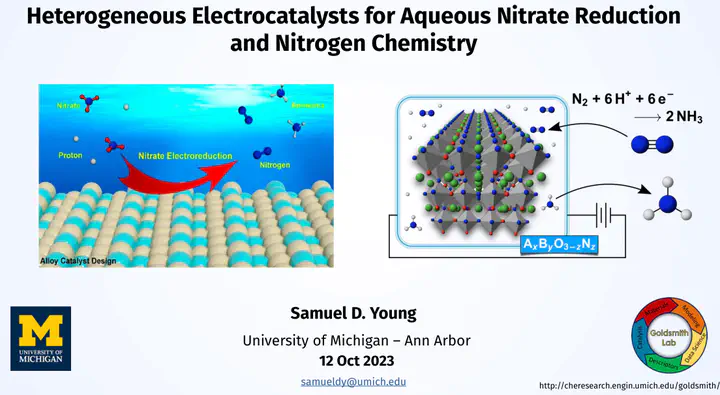
Abstract
New heterogeneous electrocatalysts promise to advance energy storage, energy production, and many industrially and environmentally important chemical processes. First-principles computational frameworks (such as density functional theory, DFT), combined with mean-field microkinetic and stability prediction models, allow us to screen large material spaces for useful and performant electrocatalysts. Here, I explore this paradigm in the context of my thesis research on balancing the global nitrogen cycle. Nitrogen cycle electrocatalysts can help prevent ovarian cancer, reduce mass aquatic ecosystem death, and make fertilizer production more sustainable. I discuss metal alloy and perovskite oxynitride catalyst materials for two nitrogen cycle reactions: nitrate reduction (NO3RR) and nitrogen reduction (NRR) to form ammonia. I first discuss PtRu alloys for NO3RR, presenting DFT calculations and a microkinetic model showing that alloying Pt and Ru in certain compositions increases the rate of NO3RR on PtRu above that of pure Pt or Ru alone. Specifically, a Pt:Ru ratio of approximately 3:1 maximizes both computationally predicted and experimentally measured NO3RR rates. Moreover, my approach of using a pure-metal microkinetic model to predict alloy performance has already been used to screen a huge space of bimetallic alloys for active NO3RR catalysts. I also explore the thermodynamic stability of perovskite oxynitrides (ABO2N and ABON2), which have been proposed as NRR electrocatalysts. I show that certain arrangements or orderings of O and N anions around the B-site cations correlate with a high degree of thermodynamic oxynitride stability. My DFT screening calculations show that highly stable perovskite oxynitrides tend to contain La, Pb, Nd, Sr, Ba, Ca, Re, or Os. Additionally, I leverage recent advances in computational Pourbaix diagrams to propose improvements to future screening studies for electrocatalyst materials. The methodologies illustrated in my work can be used to discover effective and durable battery electrodes, electrolyzer catalysts, and other energy materials beyond the context of the nitrogen cycle. Successfully discovering highly active, selective, and stable energy materials serves the ARL mission and will empower Warfighters in a variety of combat environments.